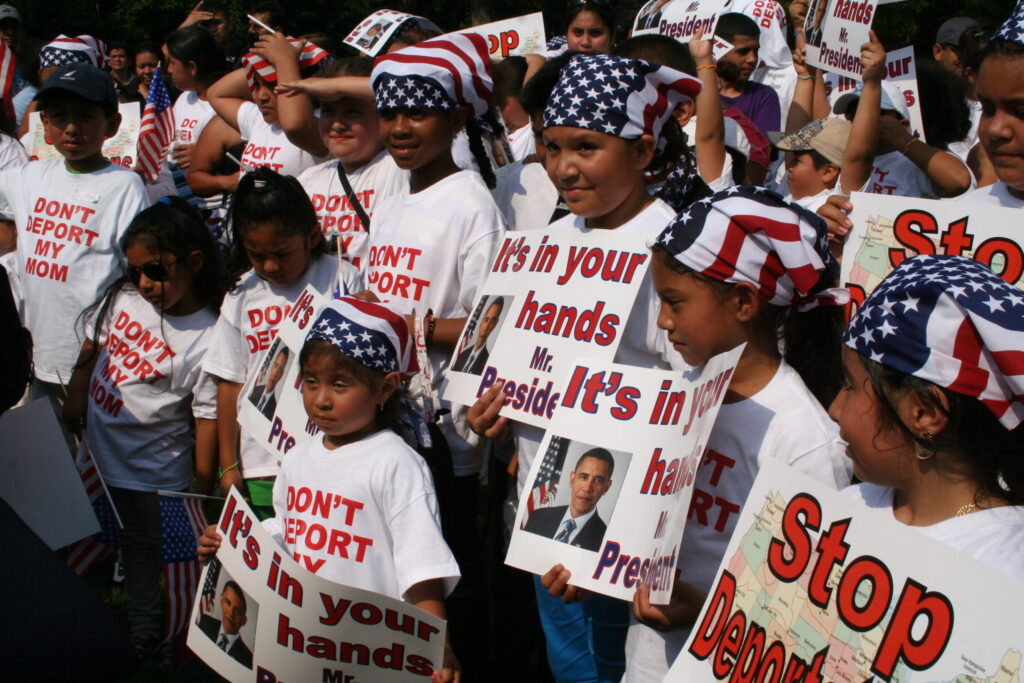The fifth and sixth questions are: “What countries did you pass through?” and “How did you travel here?” To the first one, almost everyone immediately answers “Mexico,” and some also list Guatemala, El Salvador, and Honduras. To the question about how they traveled here, with a blend of pride and horror, most say, “I came on La Bestia,” which literally means “the beast,” and refers to the freight trains that cross Mexico, on top of which as many as half a million Central American migrants ride annually. There are no passenger services along the routes, so migrants have to ride atop the rail cars or in the recesses between them.
Thousands have died or been gravely injured aboard La Bestia, either because of the frequent derailments of the old freight trains or because people fall off during the night. The most minor oversight can be fatal. Some compare La Bestia to a demon, others to a kind of vacuum that sucks distracted riders down into its metal entrails. And when the train itself is not the threat, it is the smugglers, thieves, policemen, or soldiers who frequently threaten, blackmail, or attack the people on board. There is a saying about La Bestia: Go in alive, come out a mummy.
La Bestia’s routes start either in the town of Tapachula, in the state of Chiapas, or in Tenosique, in the state of Tabasco—both towns near the Mexico–Guatemala border. They slowly make their way up to the U.S.–Mexico border, following either the eastern Gulf route to Reynosa, the border town near the southeastern-most tip of Texas, or the western routes that lead either to Ciudad Juárez, in Chihuahua, or to Nogales, in Sonora, which share borders with Texas, Arizona, and New Mexico.
There is a saying about La Bestia: Go in alive, come out a mummy.
The journey atop La Bestia’s freight trains ends at the U.S.–Mexico border. And there begins another journey: one that is not as dangerous, objectively speaking, but is equally terrifying in the children’s eyes. Once off La Bestia, and having reached the border, the coyotes’ job is usually done and the children are on their own. They try to turn themselves in to the migra, or Border Patrol, as soon as possible. They know their best bet is to be formally detained by Border Patrol officers: crossing the desert beyond the border alone is too dangerous, if not impossible. They also know that if they are not caught at this point, or if they do not surrender themselves to the law, it is unlikely that they will arrive at their final destination—the home of a relative in some city, usually far from the border. If the legal proceedings don’t begin now, their fate will be to remain undocumented, like many of their parents or adult relatives already in the United States. Life as an undocumented migrant is perhaps not worse than the life they are fleeing, but it is certainly not the life that anyone wants. So, the children who cross the border into the desert try to stick to the busier roads and walk openly along highways, until someone—hopefully an officer and not a vigilante—sees them.
I remember a teenager who, during an interview in court, told me of his increasing desperation when, after hours of walking the arid plains of New Mexico, the Border Patrol still had not appeared. It was not until his second day of walking in the desert under the burning sun that a vehicle finally appeared on the far horizon. He stood in the middle of the road, waving his arms. And when the vehicle pulled over beside him, to his immense relief, two tall officers stepped out and detained him.
“My mom always told me I was born under a lucky star,” he said when he finished his story.
As soon as a child is in the custody of Border Patrol officials, he or she is placed in a detention center, commonly known as the hielera, or the “icebox.” The icebox derives its name from the fact that the children in it are under ICE custody (Immigration and Customs Enforcement). The name also points out the fact that the detention centers along the border are a kind of enormous refrigerator for people, constantly blasted with gelid air as if to ensure that the foreign meat does not go bad too quickly—naturally, it must be harboring all sorts of deadly germs. The children are treated more like carriers of diseases than children. In July 2015 for example, the American Immigration Lawyers Association (AILA) filed a complaint after learning that in a detention center in Dilley, Texas, 250 children were mistakenly given adult-strength hepatitis A vaccinations. The children became gravely ill and had to be hospitalized.
By law, the maximum time a person can remain in the icebox is seventy-two hours, but children are often kept for longer, subject not only to the inhumane conditions and frigid temperatures but also to verbal and physical mistreatment. They sometimes have nowhere to lie down to sleep, are not allowed to use the bathrooms as frequently as they need to, and are underfed.
“They only give out frozen sandwiches twice a day there,” another teenager I once screened told me.
“That’s all you ate?” I asked.
“No, not me.”
“What do you mean, not you?”
“I didn’t eat those things.”
“Why not?”
“Because they give belly-sadness.”
Question seven on the questionnaire is “Did anything happen on your trip to the U.S. that scared you or hurt you?” The children seldom give details of their experiences along the journey through Mexico upon a first screening, and it is not necessarily useful to push them for more information. What happens to them between their home countries and their arrival in the United States cannot always help their defense before an immigration judge, so the question does not make up a substantial part of the interview. But, as a Mexican, this is the question I feel most ashamed of, because what happens to children during their journey through Mexico is always worse than what happens anywhere else.
‘My mom always told me I was born under a lucky star,’ he said.
The numbers tell horror stories. Rapes: 80 percent of the women and girls who cross Mexico to get to the U.S. border are raped on the way. The situation is so common that most of them take contraceptive precautions as they begin the journey north. Abductions: in 2011 the National Human Rights Commission in Mexico published a special report on immigrant abductions and kidnappings, revealing that the number of abduction victims between April and September 2010—a period of just 6 months—was 11,333. Deaths and disappearances: though it is impossible to establish an actual number, some sources estimate that, since 2006, around 120,000 migrants have disappeared in their transit through Mexico.
Beyond the terrifying but abstract statistics, many horror stories have recently tattooed themselves in the collective social conscience in Mexico. One specific story, though, became a turning point. On August 24, 2010, the bodies of seventy-two Central and South American migrants were found, piled up in a mass grave, at a ranch in San Fernando, Tamaulipas. Some had been tortured and all had been shot in the back of the head. Three migrants in the group had faked their deaths and, though wounded, survived. They lived to tell the complete story: members of the drug cartel Los Zetas had perpetrated the mass murder after the migrants had refused to work for them and did not have the means to pay a ransom.
I remember the dark days when this news broke out in Mexico—thousands or perhaps millions of people in front of newspapers, radios, and TV screens, all of them asking: How? Why? What did we do? Where did we go wrong, as a society, to make some thing like this possible? Even now, we don’t know the answer. No one does. What we do know is that, since then, hundreds of additional mass graves have been discovered. Every month, every week, they continue to be discovered. And even though the story of “Los 72”—the 72 men and women, girls and boys, all brutally murdered—changed the way in which both Mexican society and the rest of the world views the situation of migrants crossing Mexican territory, nothing has actually been done about it.
There are, of course, some redeeming stories in Mexico. There is the story of Las Patronas, the group of women in Veracruz who, years ago, started throwing bottled water and food to the migrants aboard La Bestia and are now a formal humanitarian group. There are also the many shelters that offer food and refuge to migrants as they travel through Mexico, the most well known of which is Hermanos en el Camino, run by Father Alejandro Solalinde. But these stories—small oases in the no man’s land Mexico has become—are only exceptions. If anything, they are fleeting glints of hope in the dark and raucous nightmare where the metal wheels of La Bestia continually screech and howl.
So when I have to ask children that seventh question—“Did anything happen on your trip to the U.S. that scared you or hurt you?”—all I want to do is cover my face and my ears and disappear. But I know better, or try to. I remind myself to swallow the rage, grief, and shame; remind myself to just sit still and listen closely, in case a child does happen to reveal a particular detail that can end up being key to his or her defense against deportation.
The danger migrants face in their journeys does not end when they finally reach the U.S.–Mexico border. Question number eight addresses crimes and rights violations in U.S. territory: “Has anyone hurt, threatened, or frightened you since you came to the U.S.?”
The stories of deepest horror are those for which there are no numbers, no maps, no possible accountability, no words ever written or spoken.
There are many stories about such violations. Some are liminal, such as the well-known case of a sixteen-year-old boy on the Mexican side of the border who in 2012 was shot to death by an American officer on the U.S. side. The officer later claimed the boy and other people had thrown rocks at him. The officer argued self-defense: his bullets for their rocks. And the dangers continue once the border is crossed. We know, for instance, that civilian vigilantes and owners of private ranches go out to hunt undocumented migrants, either as a matter of conviction or merely for sport.
Many migrants also die of dehydration, hunger, or accidents. At the forensic institute of Pima County, Arizona, alone, more than 2,200 human remains have been registered since 2001, the majority of which are still unidentified. The area surrounding the border between Mexico and the United States is a big common grave. The migrants who die in this portion of our continent become no more than “bones in the desert,” as Sergio González Rodríguez once said about the many women murdered in and around Ciudad Juárez during the peak of the femicide crisis, perhaps also foreshadowing the destiny of many more people. It is almost impossible to identify human remains recovered from the desert, as they are frequently discovered in a very advanced state of decomposition and the lines of communication between family members looking for their missing and the institutions responsible for the remains are limited, if not completely absent. One notable effort to counter this desolating map of current and future anonymous dead was organized by the nonprofit Humane Borders, which, among other important work, created an online search mechanism that matches names of deceased migrants to the specific geographical coordinates in the desert where their remains were found. That way, family members of the missing can type a name into a search bar and either confirm their worst fears, when the map zooms in on a red dot in the desert, or continue to wait and hope. Writer and former Border Patrol officer Francisco Cantú has written poignantly about these death maps and all the “clearly marked ghosts” that dot the wide deserts in the southern United States.
Numbers and maps tell horror stories, but the stories of deepest horror are perhaps those for which there are no numbers, no maps, no possible accountability, no words ever written or spoken. And perhaps the only way to grant any justice—were that even possible—is by hearing and recording those stories over and over again so that they come back, always, to haunt and shame us. Because being aware of what is happening in our era and choosing to do nothing about it has become unacceptable. Because we cannot allow ourselves to go on normalizing horror and violence. Because we can all be held accountable if something happens under our noses and we do not dare even look.






